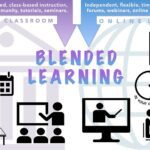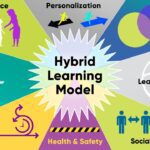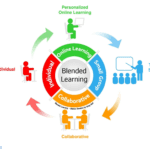Blended Learning in Corporate Training

You’ve probably heard people talking about blended learning in recent weeks. This isn’t one of those fancy corporate terms that will just go away, because blended learning and blended training works if it is done right. I have personally witnessed businesses struggling for years with monotonous training sessions filled with mind-numbing lectures, but once incorporating online and face-to-face interactions, that’s when things started rolling.
Let me put it this way. We are referring to teaching in class live or virtually alongside self-directed learning with digital aids. It sounds fairly simple, but like every other thing in the world, there is artistry in getting it correctly. Striking the right balance between virtual and in-person can be tricky, as too much of one leads to feelings of isolation. The right mix? Depends on your team.
Different companies have found many ways to make this work, which is really exciting. Some begin with short video lessons followed by hands-on workshops, while others flip it-theory at home, practice at work. None of these are wrong because of the fact that they educated tailored solutions. The best part is you get to customize based on what your people actually need instead of relying on outdated training manuals.
I won’t lie, as with anything, this shift is not always smooth. Some people don’t adapt to new technology. Others prefer the comfort of conventional training. But when it works? All of a sudden, you have people who recall what they were taught months down the line. This is the result of combining digital modalities with…
Introduction
With the ever-changing landscape of corporate training, organizations are actively looking for solutions to improve their learning and development programs. Blended training, comprising integration of face-to-face and online learning, has become a powerful solution. Learning management systems and digital platforms make it easier to facilitate all the great aspects of instruction with the benefits of digital learning, resulting in a more engaging and impactful experience.
What is Blended Learning?
Hands-on blended learning in the classroom is the method of teaching that combines traditional face-to-face learning with online digital media. It blends early in-person gatherings, live instructor-led sessions, and online modules that can be completed at your pace. With the combination of these two modalities, blended studying seeks to enrich the studying experience and make it more flexible and customized to the various preferences of learners.
Benefits of Blended Learning

Blended training brings numerous advantages to corporate training programs. Firstly, it allows employees to access learning materials anytime, anywhere, fostering convenience and flexibility. Secondly, it promotes learner engagement through interactive online activities, discussions, and multimedia content. Thirdly, it enables personalized learning by accommodating different learning styles and paces. Lastly, it enhances knowledge retention by reinforcing key concepts through a combination of face-to-face instruction and online reinforcement activities.
Challenges of Blended Learning
While blended training offers significant benefits, it also presents challenges that organizations must address. One challenge is the need for robust technological infrastructure to support the online learning components. Additionally, ensuring a smooth transition between in-person and online learning can be challenging for both instructors and learners. It is vital to establish clear communication channels and provide adequate technical support to overcome these challenges.
Blended Learning in Corporate Training
Blended training has gained traction in corporate training due to its effectiveness in fostering skill development and employee engagement. Organizations are leveraging this approach to deliver training programs that align with the unique needs of their workforce.
Advantages of Blended Learning
Blended training offers several advantages in the context of corporate training. Firstly, it allows organizations to combine the best elements of instructor-led sessions and online resources, creating a comprehensive and well-rounded learning experience. Secondly, it enables companies to reduce training costs by utilizing online modules for content delivery and focusing in-person sessions on practical application and collaboration. Lastly, it promotes continuous learning by providing employees with ongoing access to resources and opportunities for self-paced learning.
Examples of Blended Learning
Numerous organizations have successfully implemented blended learning in their corporate training programs. For instance, a multinational technology company combines in-person workshops with online simulations and interactive modules to train its salesforce on new product features. Similarly, a healthcare organization employs a blend of virtual classrooms, self-paced e-learning modules, and on-the-job training to enhance the skills of its medical staff. These examples highlight the versatility of blended learning and its applicability across diverse industries.
Hybrid Learning: A Key Component of Blended Learning

Within the blended learning framework, hybrid courses plays a crucial role. It refers to the integration of online and offline elements in a course or training program. Hybrid courses combines the benefits of face-to-face interactions with the flexibility and scalability of online resources, creating a cohesive and dynamic learning environment.
Understanding Hybrid Learning
Hybrid learning is characterized by a thoughtful blend of synchronous and asynchronous learning activities. Synchronous activities involve real-time interactions between instructors and learners, while asynchronous activities allow learners to access resources and complete assignments at their own pace. This combination promotes active engagement, collaboration, and independent learning.
Blending Online and Offline Elements
To design an effective hybrid course, it is essential to strike a balance between online and offline elements. In-person sessions can be utilized for hands-on activities, group discussions, and direct feedback from instructors. Online components can include multimedia resources, quizzes, discussion forums, and virtual simulations. By blending these elements strategically, instructors can create an enriching and interactive learning experience.
Types of Blended Learning Models
Blended learning encompasses various models, each offering a unique combination of in-person and online learning components. Here are some commonly used models:
Rotation Model

In the rotation model, learners rotate between different learning stations, which can include online modules, small group activities, and face-to-face instruction. This model allows for personalized instruction and enables learners to work at their own pace while receiving targeted support from instructors.
Flex Model
The flex model provides learners with flexibility in terms of time, pace, and place of learning. It combines online modules with periodic in-person sessions, giving learners the autonomy to determine their learning schedule and progress. Instructors serve as facilitators, providing guidance and support as needed.
Self-Blend Model
In the self-blend model, learners supplement their traditional classroom instruction with online resources and activities. This model allows for personalized learning, as learners can explore topics of interest in more depth or revisit challenging concepts through online materials.
Enriched Virtual Model

The enriched virtual model involves a significant portion of learning taking place online, with periodic face-to-face sessions for collaboration, discussions, and practical application. This model offers the flexibility of online learning while maintaining valuable in-person interactions.
Designing a Hybrid Course
Designing a hybrid course requires careful planning and consideration of various factors. Here are some key steps to create an effective hybrid training experience:
Setting Learning Objectives
Begin by defining clear and measurable learning objectives. These objectives will guide the selection of appropriate content, activities, and assessments for the course. Check out our resource on how to create a clear and confined learning objectives.
Selecting Appropriate Content
Choose content that aligns with the learning objectives and engages learners. Utilize a mix of multimedia resources, interactive modules, and real-world examples to cater to different learning styles and enhance comprehension.
Utilizing Technology Tools
Leverage technology tools to facilitate online interactions, content delivery, and assessments. Use learning management systems, video conferencing platforms, and collaboration tools to create a seamless learning experience. Check out our resources on top AI tools that can be used in a classroom/ virtual training environment.
Blended Teaching Strategies
To enhance the effectiveness of blended learning, instructors can employ various teaching strategies that foster engagement, collaboration, and personalized learning. Here are some examples:
- Flipped Classroom
In a flipped classroom approach, learners review online materials and resources before attending in-person sessions. Instructors then utilize face-to-face time for discussions, problem-solving activities, and practical application of concepts.
- Collaborative Learning

Encourage collaborative learning by incorporating group projects, discussions, and peer feedback. Online platforms can facilitate virtual collaboration, enabling learners to work together regardless of their physical location. Check out our free resources to learn more about collaborative learning.
- Personalized Learning
Tailor the learning experience to meet the individual needs of learners. Provide opportunities for self-paced learning, personalized feedback, and adaptive assessments to accommodate different learning styles and preferences.
Conclusion
Blended learning, with its integration of face-to-face and online learning components, offers a powerful approach to corporate training. By leveraging hybrid training and implementing effective blended teaching strategies, organizations can enhance employee skills, engagement, and overall learning outcomes. Embracing this dynamic and flexible approach to training can lead to improved performance, increased productivity, and a culture of continuous learning within organizations.

![The Power of Storytelling in Corporate Training: Igniting Success and Inspiring Growth [2023]](https://trainercentric.com/wp-content/uploads/2023/06/storytelling-1024x576.jpg)

